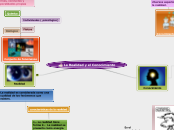FUNDAMENTOS DE LA ILUSTRACION
Name the character
Type in the name of the character whose change throughout the story you are going to analyze.
Example: Nick Carraway.
TECNICAS
Character's behavior
Think of the character's behavior at the beginning of the story and look for the way it changed throughout the story.
Húmedas
Acrílico
Oleo
Acuarela
Change in behavior
In what way did the character change the other behavior(s) you mentioned? Type in a relevant quote.
Example:
'You said a bad driver was only safe until she met another bad driver? Well, I met another bad driver, didn't I? [...]
I thought you were rather an honest, straightforward person. I thought it was your secret pride.'
Tempera
Change in behavior
How did the character change the first behavior you mentioned? Type in a quote to prove your statement.
Example: Nick assumes the whole responsibility for Gatsby's funeral arrangements, 'with that intense personal interest to which every one has some vague right at the end.'
Secas
Collage
Carboncillo
Marcadores
Initial behavior
What is the character's behavior at the beginning of the story? Type in a relevant quote for your statement.
Example: Nick seems to be an honest person, calling himself 'one of the few honest people that I have ever known'.
Lápices de colores
Lápiz
Initial behavior
How does the character act at the beginning of the story? Type in a relevant quote for your statement.
Example: Nick shows his immature side as he leaves to New York in order to avoid 'being rumored into marriage' with his girlfriend.
ESTILO
Pintura
Composición
Formas
Colores
Características particulares
¿Cuáles son los fundamentos de la ilustración?
Los pensadores de la Ilustración sostenían que el conocimiento humano podía combatir la ignorancia, la superstición y la tiranía para construir un mundo mejor. La Ilustración tuvo una gran influencia en aspectos científicos, económicos, políticos y sociales de la época.
En la segunda mitad del siglo XVIII, pese a que más del 70% de los europeos eran analfabetos, la intelectualidad y los grupos sociales más relevantes descubrieron el papel que podría desempeñar la razón, íntimamente unida a las leyes sencillas y naturales, en la transformación y mejora de todos los aspectos de la vida humana. Para entender correctamente el fenómeno de la Ilustración hay que recurrir a sus fuentes de inspiración fundamentales: la filosofía de Descartes -basada en la duda metódica para admitir sólo las verdades claras y evidentes- y la revolución científica de Newton, apoyada en unas sencillas leyes generales de tipo físico.
Los ilustrados pensaban que estas leyes podían ser descubiertas por el método cartesiano y aplicado universalmente al gobierno y a las sociedades humanas. Por ello, la élite de esta época sentía enormes deseos de aprender y de enseñar lo aprendido, siendo fundamental la labor desarrollada por Diderot y D'Alembert cuando publicaron la Encyclopédie raisonée des Sciences et des Arts entre 1751 y 1765, completada en 1764 con el Dictionnaire philosophique, de Voltaire
APLICACION
Infantil
Editorial
Video juegos
Comic
TIPOS DE ILUSTRACION
Character's feelings
Focus on the way the character's feelings are presented at the beginning and at the end of the story, while explaining why they have changed.
Literal
Se imprime a las obras un carácter más bien colectivo y moral, más centrado en lo civil y lo impersonal.
The reason for the change of feelings
What caused the character to change the first belief you mentioned? Type in the reason for the change.
Example: disgust towards the lack of morality in the Buchanan family.
Conseptual
desarrolla una idea personal nacida de las consideraciones que hace el ilustrador acerca del tema que se propone ilustrar.
Change of feelings
How did the character change the belief you mentioned?
Type in a relevant quote for his change.
Example: 'Winter night and the real snow, our snow(...)We drew in deep breaths of it . . . unutterably aware of our identity with this country for one strange hour before we melted indistinguishably into it again. That's my middle-west.' - Nick on the purity and integrity of Midwest.
Tradicional
es el tipo “clásico” de ilustración, en el que se dibuja y pinta a mano.
Initial feelings
How does the character feel about a certain subject at the beginning of the story? Type in a relevant quote to support your statement.
Example: "Reserving judgements is a matter of infinite hope."
Digital
Aplicar color y filtros que alteran la imagen son tareas más sencillas y rápidas
Los trazados son más rápidos. Los efectos fotográficos o visuales se aplican instantáneamente y de forma reversible.
Ilustración es acción y efecto de ilustrar. También, es aclarar un punto o materia con palabras, imágenes, o de otro modo, asimismo, es adornar un impreso con láminas o grabados para hacerlo más atractivo a la vista o explicar de mejor manera su contenido.
Title
Type in the title and author of the literary work that introduces the character.
Example: The Great Gatsby, by F. Scott Fitzgerald.
Se denomina ilustración, al dibujo, estampa o grabado que adorna, documenta, narra o recrea en conjunto con el texto escrito de un libro. Es el componente gráfico que complementa o realza un texto.
DEFINICION









